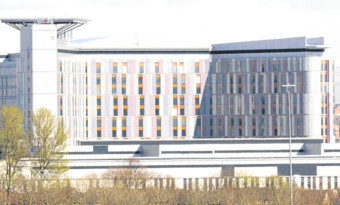
Visitors to a £1billion super-hospital keep getting trapped in the lifts.
Elevators at the new 14-storey South Glasgow University Hospital have no buttons inside them.
As a result staff and visitors keep getting caught out by jumping into the lifts without selecting the floor they want first.
Bemused people have spent “what seems like days” trapped in the speeding elevators, surfing between the building’s floors.
One hospital worker said: “It’s an amazing building but I’ve spent the majority of my time in the lift so far as have a lot of people. You can easily get sucked into them for what seems an interminable age.
“If you jump in without thinking, or if you’re chatting and not concentrating, you can find yourself for what seems like hours zooming from floor to floor.
“I had to go just one floor up, not long after arriving. I jumped into the lift without pressing the button and was lost for nearly half an hour!
“The staff will get used to it, but it catches newcomers to the building out time and time again.”
https://youtube.com/watch?v=sAz_UvnUeuUTravelling
in a lift can be a challenging experienceThe lifts only travel to pre-selected floors.
NHS bosses have now enlisted staff and volunteers to explain how to use them properly.
There are even animated films to help people figure out how to negotiate the new building.
Nicknamed the “Death Star”, because of its imposing star-shaped design, the £1 billion hospital was funded by the Scottish Government.
The lifts are just one aspect of a futuristic design that also sees the hospital boast self-service check-in machines and a fleet of robots delivering linen and other goods via a network of tunnels.
Other teething problems include complaints there are too few parking spaces and even claims there are not enough beds.
A spokeswoman for NHS Greater Glasgow and Clyde defended the new lifts, but acknowledged it may take time for people to get used to them.
She said: “These lifts have been chosen because they offer the best way to get our patients to their chosen floor as quickly as possible.
“But we recognise adapting to new technology can take a bit of getting used to, which is why there are plenty of staff and volunteers available to help users find their way around and get to grips with some of the new technologies in place.
“We have also developed a series of short animated films which are available on our website and TV screens in GP practices to help users understand how find their way around.”

Enjoy the convenience of having The Sunday Post delivered as a digital ePaper straight to your smartphone, tablet or computer.
Subscribe for only £5.49 a month and enjoy all the benefits of the printed paper as a digital replica.
Subscribe